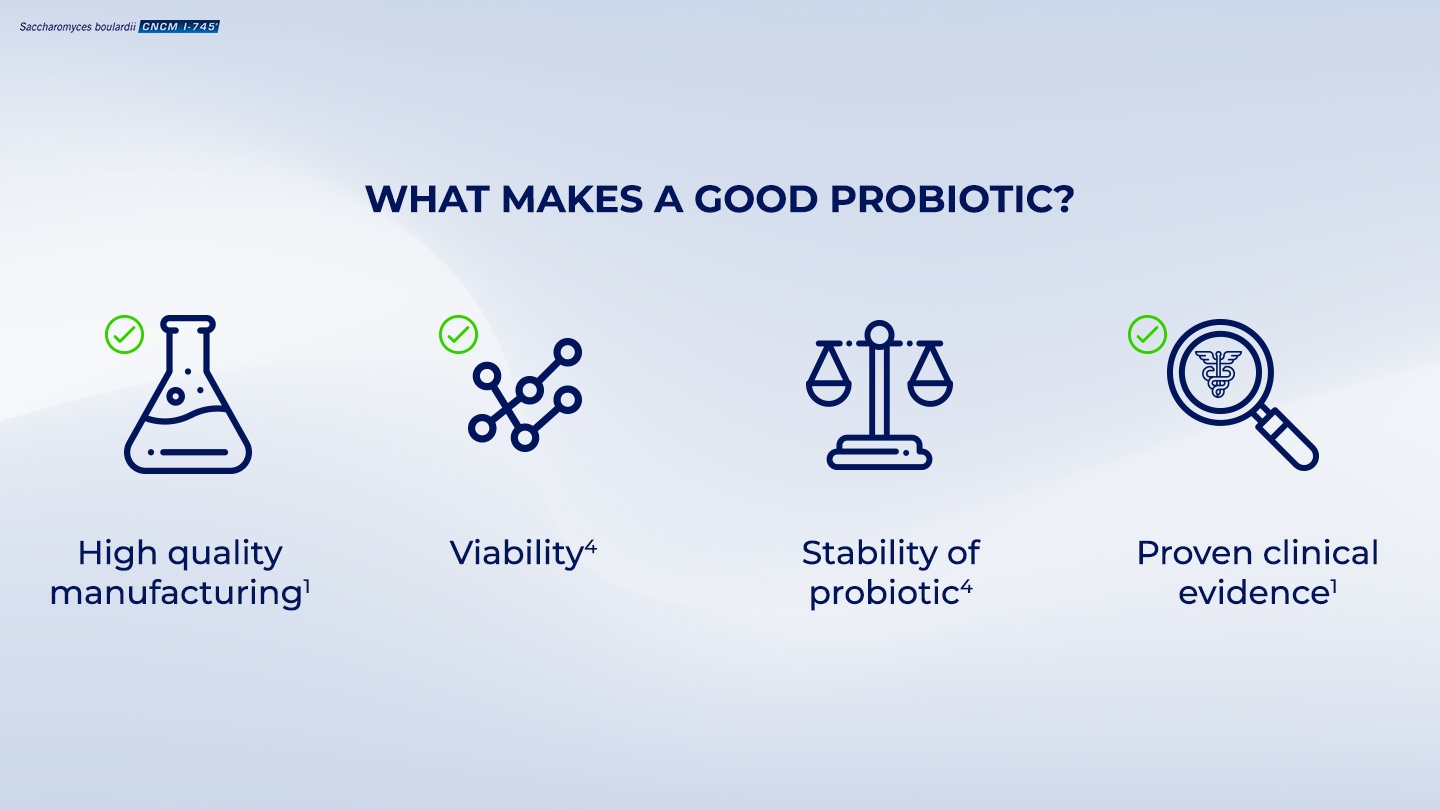Saccharomyces boulardii CNCM I-745 has a unique manufacturing process
- 4 min
At the heart of Saccharomyces boulardii CNCM I-745’s proven health benefits is a highly rigorous manufacturing process.
Probiotics are living microorganisms that when taken in an adequate amount, offer a health benefit.1 The health benefits of the probiotic should always be 1) clinically proven (tested in clinical studies with human participants)1, and 2) manufactured in a way that guarantees it remains active.1
A range of probiotic products are available, from probiotic drugs, to food supplements.2 Whether a probiotic is classified as a drug or a food supplement depends on the quality of clinical evidence supporting it and high-quality manufacturing. For instance, S. boulardii CNCM I-745 was the first probiotic used in human medicine2 and is a probiotic drug in most countries because it is subjected to the same rigorous assessments as other drugs2.
The viability of a probiotic is key. Viability means that it survives the manufacturing process1, survives storage1, and survives its journey through the stomach and the intestine.3

(Internal code : 20.60)
A variety of factors during the manufacturing process can kill the living microorganisms, which affects the health benefit(s) of the probiotic, including : 4
- How it is produced
- How it is stabilized for packaging and storage (freezing, freeze drying, spray drying)
- Pharmaceutical formulation (sachet, capsules), packaging process (blister, bottle, foil)
- Probiotic storage conditions (room temperature vs. refrigeration)
This ensures that the quality of the product has been verified, so that viability, stability and activity are guaranted.5 Studies investigating different probiotics showed that not all probiotics had the amount of microorganism that was stated on the package, or had incorrect strains listed.3 And, some manufacturing processes are better than others.3
For example, it has been shown that heat-dried probiotics lose efficacy rapidly and are not stable at room temperature.3 This means that they must be used quickly and need to be stored in the fridge.3
S. boulardii CNCM I-745 is a lyophilized probiotic.2 This means that it has been freeze-dried in a process that removes water to dehydrate it (the same process as astronaut food!).This process has been shown to lead to quicker recovery speed and growth once the probiotic has reached the gut.3 It is this unique manufacturing process that ensures the viability and activity of S. boulardii CNCM I-745.2
Since high quality manufacturing and proven efficacy of a probiotic directly influence the use and recommendation for various conditions6, because of the quality of S. boulardii CNCM I-745 evidence, the yeast is recommended in guidelines for the treatment and prevention of diarrhea*, including the European Society for Pediatric Gastroenterology, Hepatology, and Nutrition6,7, and the World Gastroenterology Organization.1
*The prescribed usage of Saccharomyces boulardii CNCM I-745 for different conditions varies country to country. Please refer to the Product Information specific to your country or speak with your physician.
Internal code : 20.06
References
- 01 . Guarner et al. Probiotics and prebiotics. World Gastroenterology Organisation Global Guidelines. February 2017. https://www.worldgastroenterology.org/guidelines/global-guidelines/probiotics-and-prebiotics/probiotics-and-prebiotics-english. Last accessed 13th December 2019
- 02 . Marteau, P and Dore J (Ed.). Gut Microbiota: A full-fledged organ. 2017: 291-292;302; 305,326. Paris: John Libbey Eurotext.
- 03 . McFarland, LV. Systematic review and meta-analysis of Saccharomyces boulardii in adult patients. World journal of gastroenterology: WJG. 2010 ; 16(18) : 2202.
- 04 . Sanders ME, et al. Effects of genetic, processing, or product formulation changes on efficacy and safety of probiotics. Annals of the New York Academy of Sciences. 2014; 1309(1): 1-18.
- 05 . Passariello A, Agricole P, and Malfertheiner P. A critical appraisal of probiotics (as drugs or food supplements) in gastrointestinal diseases. Current medical research and opinion. 2014; 30(6): 1055-1064.
- 06 . Szajewska H, et al. Probiotics for the prevention of antibiotic-associated diarrhea in children. Journal of Pediatric Gastroenterology and Nutrition. 2016 ; 62(3) : 495-506.
- 07 . Guarino A, et al. European Society for Pediatric Gastroenterology, Hepatology, and Nutrition/European Society for Pediatric Infectious Diseases evidence-based guidelines for the management of acute gastroenteritis in children in Europe: update 2014. Journal of pediatric gastroenterology and nutrition. 2014; 59(1): 132-152.
